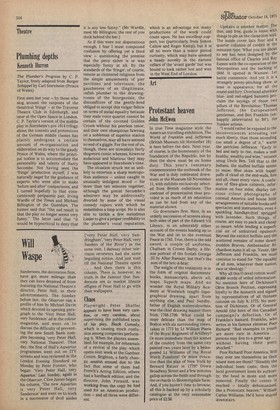Art
Protestant heaven
John McEwen
In true Time magazine style the American travelling exhibition, The World of Franklin and Jefferson (British Museum till November 16) is here before the date. Next year, of course, is the bicentenary of the foundation of the Republic, but by then the show must be on home duty. This year's centenary commemorates the outbreak of the War and is duly celebrated downstairs at the Museum till November 11, with exhibits exclusively selected from British collections, The contrast of presentation thus provided is as much of an education as can be had from any of the material shown.
Go downstairs first. Here, in an orderly succession of screens along both sides of part of the Edward VII Library, is an admirably sober account of the events leading up to the War and on to the eventual Peace in 1783. True, there is the odd sword, a couple of uniforms, Chatham in Crown Derby, a lifesize portrait of the foolish George III by Allan Ramsay, but that's the sum of the bric-a-brac.
The weight of the testimony is in the form of original documents: books, manuscripts, above all, maps. Superb maps. And no wonder: the Royal Military Academy at Woolwich taught topographical drawing, apart from anything else, and Paul Sandby, father of English watercolourists, was the chief drawing master there from 1768-1799. What could be more delicate than the map of Boston with six surrounding views, taken in 1773 by Lt William Pierie of the Royal Regiment of Artillery? Or more immediate than the scenes of the country from the same city painted two years later by a beleaguered Lt Williams of the Royal Welch Fuseliers? Or more evocative than the plan of New York by Bernard Ratzer in 1770? Down Broadway Street and a few minutes gallop across the fields and through the orchards to Bloomingdale farm. And, if you haven't time to browse, all this is backed up by a scholarly catalogue at the very reasonable price of £2.50. Upstairs is another matter. The thin, and free, guide is loose with things to pin on the classroom wall. The inside cover lists four and a quarter columns of credits in the minutest type. What you are about to see has been designed by the famous office of Charles and Ray Eames with the co-operation of the Metropolitan and the backing of IBM. It opened in Warsaw. Let battle commence. And yet it is a strangely penny-pinching show, at least in appearance, for all the sound and fury. Overhead alternate blueand red-edged banners proclaim the sayings of those two pillars of the Revolution, Thomas Jefferson, the Europeanised gentleman, and Ben Franklin (unhappily abbreviated to BF), the Yankee artisan.
"I would rather be exposed to the inconveniences attending too much liberty, than those attending too small a degree of it," warns the patrician Jefferson. "Early to bed and early to rise, makes a man healthy, wealthy and wise," intones smug Uncle Ben. Tell that to the Indians, the stuffed buffalo seems to muse. Blue skies with hapPY puffs of cloud on the end-walls, fore and aft, cheer every view. A confusion of fibre-glass cabinets, information on four sides, display luscious colour photographs of colonial America and house little arrangements of suitable books and spectacles and instruments, even a sparkling handkerchief sprigged with lavender. Such things, of course, are easy to pack and cheap to insure, while lending a superficial air of unhurried opulence. Beyond the extinct buffalo and the scattered remains of some downtrodden Braves, Ambassador Richardson sums it all up. Yessir, Jefferson and Franklin, we must continue to stand for "the equalitY of all men, whatever their nation, race or ideology."
Why all this 0-level cotton wool? 40,000 words of veiled information. No mention here of Dickinson's Olive Branch Petition, expressing loyalty to the monarch and signed by representatives of all thirteen colonies on July 8, 1775. No mention of Dickinson. Or of General Arnold (the hero of the Canadian campaign)'s defection. Or of Franklin's bastard. Franklin, who writes in his famous almanac Poor Rickard: "Bad examples to youth are more rare in America persons may live to a great age .. • without having their piety shocked."
Poor Richard! Poor America. .Will they ever see themselves as their wisest men see them? "Steadily the individual loses caste, then the local government loses its authority; the head is more and more removed. Finally the centre is reached — totally dehumanised, like a Protestant heaven." William Carlos Williams. He'd have stayed downstairs.


































 Previous page
Previous page